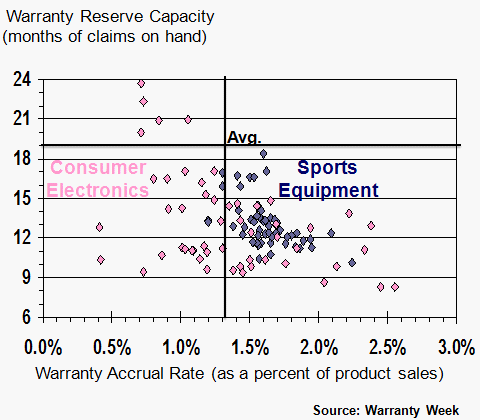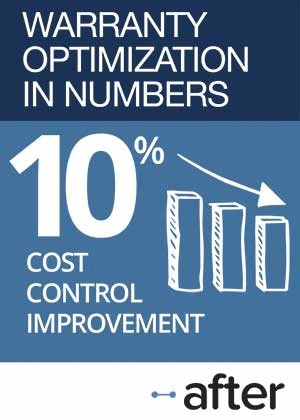Sports Equipment & Consumer Electronics Warranty Report:While they're not the top sources of warranty expenses, there is a lot of warranty activity in these industries. So rather than bury their claims and accruals in the "other" category, let's take a look at the warranty costs of everything from karaoke machines to golf clubs.
As we near the end of our tour of the 17 industry categories into which all warranted product fall, we get to two that feature more as extended warranty opportunities than they do as origins of product warranty expenses. Sports equipment and consumer electronics, while they sell well and support a lot of retailers in terms of revenue and profits, are not generally known as top sources of warranty claims.
A big reason for this is the fact that the U.S.-based portion of the consumer electronics industry is merely a fraction of total consumer electronics sales. Most of the gear is imported, and those few internationally-based manufacturers that actually do report their warranty expenses are not part of this week's report. But we do have some data for Sony, Panasonic, Canon, and a handful of others that we will get to in a newsletter in early July.
Having said that, we did find 65 U.S.-based consumer electronics manufacturers, who make everything from speakers and headphones to navigational gear, radar detectors, karaoke machines, voicemail systems, surge protectors, and lottery machinery, among other items. To slim down the list and avoid repetition, we did not include any of the PC, smartphone or hard disk makers that we covered in the Computer Industry Warranty Report, even though companies such as HP, Microsoft and Apple are leading the resurgence of the U.S.-based consumer electronics industry. Nor did we include any of the consumer-oriented data communications equipment companies that we covered in the May 5 newsletter.
Instead, we included companies such as Eastman Kodak Co., Harman International Industries Inc., Garmin Ltd., GoPro Inc., Skullcandy Inc., Singing Machine Co., Universal Electronics Inc., and InvenSense Inc., whose brands are typically stocked in consumer electronics outlets. But we did borrow a handful of telecom and data storage companies, such as SanDisk Corp., Polycom Inc., and Plantronics Inc., whose products are frequently used in game consoles, digital cameras, audio/video entertainment systems, and other categories of CE hardware.
Sports Equipment Warranties
For our roster of 48 sports equipment manufacturers, we borrowed heavily from other industries, because there simply aren't that many publicly-traded and U.S.-based companies making balls, bats, helmets, and golf gear any more. There's still Johnson Outdoors Inc., Callaway Golf Co., Nautilus Inc., and Jarden Corp., but companies such as Easton-Bell Sports Inc., Adams Golf Inc., Aldila Inc., LaCrosse Footwear Inc., GolfGear International Inc., and AMF Bowling Worldwide Inc. have either been acquired, gone private, or gone out of business since 2003.
So instead, we pulled in a few select sports vehicle makers such as Harley-Davidson Inc., Polaris Industries Inc., and Arctic Cat Inc., and boat makers such as Brunswick Corp. and Marine Products Corp. And we included others such as Signet Jewelers Ltd., Smith & Wesson Holding Corp., Taser International Inc., Movado Group Inc., Collectors Universe Inc., and Tumi Holdings Inc., that simply don't fit into any other industry category.
These two collections of somewhat dissimilar companies are complementary, in the sense that they reflect the warranty activity of true consumer discretionary product manufacturers. You really don't need to buy a new set of headphones or a new bowling ball in the same way that you might need to buy a new car or a television set, so their warranty expenses rise and fall with sales, and their sales are extremely sensitive to market conditions.
In Figure 1, one can see exactly when the recent recession began to cut into sales, and when the growth stopped. Here we're tracking claims, which peaked for the sports equipment makers in 2008 and for the consumer electronics companies in 2009. Last year, the sports equipment makers did actually see a $35 increase in claims payments, but the consumer electronics companies saw a $12 million drop in claims payments. Sports equipment claims have been essentially flat for a decade now, but for consumer electronics the decline continues into its fifth consecutive year.
Figure 1
Sports Equipment & Consumer Electronics Warranties
Claims Paid Worldwide by U.S.-based Manufacturers
(in US$ millions, 2003-2015)
We're not including Microsoft, so none of that 2008-09 bulge in CE claims can be traced to the Xbox. Instead, it was due to companies like Garmin and Kodak having some bad years, with even Harman International seeing a spike in claims in 2008. They're all under control now, with Garmin down to one-fourth its peak, Kodak cutting its claims in half last year, and Harman holding steady with a 2015 rise in claims well below its sales increase. SanDisk, which was acquired last month by Western Digital, closed out its last year as a separate company with a $3.7 million decline in claims.
On the sports side, Signet Jewelers saw a $5.7 million increase in claims in 2015, but that's no doubt linked to its acquisition of Zale Corp., which helped turn it into the world's largest retailer of diamond jewelry. Yes, some jewelry is covered by product warranties, and yes, those warranties actually have a claims cost associated with them.
Other changes of note include Harley-Davidson with a 30% increase in claims last year, and Polaris with a 14% increase. Meanwhile, Brunswick saw its claims rise by $3.9 million, or about 7%, but that's a company-wide increase, so we don't know if it arose from its lineup of boats, marine engines, fitness gear or billiard tables.
In terms of decreases, among the majors, Arctic Cat saw a 20% decline in claims paid last year, from $$18 to $14.4 million. Also, there was an $8.6 million decline in claims last year at Jarden, but again we can't be sure if it came from its Coleman or Rawlings lines of sports equipment or from one of its numerous brands of kitchen appliances. And this year, Jarden was acquired by Newell Rubbermaid, which only occasionally reports its warranty reserve balance and never reports how much it spends on claims. So we may never again know how those brands are doing in terms of warranty expenses.
Warranty Accruals
With warranty accruals, it's much the same pattern. As can be seen in Figure 2, the peaks came a bit sooner -- in 2007 for the sports equipment companies and in 2008 for the CE makers. But that's to be expected, because under normal accounting practices the companies would set aside the funds before the bills needed to be paid. And since then, it's been more or less the same, with sports equipment accruals relatively flat for a decade and CE accruals slowly diminishing.
The CE total was $170 million, its smallest ever and $25 million below 2014's total. The sports equipment companies cut their accruals by $12 million to $410 million, but they've been a little above or a little below $400 million since 2008, with no apparent trend.
Figure 2
Sports Equipment & Consumer Electronics Warranties
Accruals Made Worldwide by U.S.-based Manufacturers
(in US$ millions, 2003-2015)
The 2008-09 bulge in CE accruals was once again caused primarily by Harman, Garmin, and Kodak. And once again, they each have it under control now. Harman cut its accruals by $9.1 million last year, while Garmin boosted its by a mere $197,000. Kodak, which has a radically reduced product line and sales total, cut its accruals to $7 million in 2015, its lowest total yet. SanDisk and Polycom also cut their accruals last year.
On the sports side, once again Signet led the accrual increases, but it's a much larger company after absorbing Zale's. Polaris boosted its accruals by $12 million, but its sales grew 26%, so proportionally its accruals are actually falling.
Brunswick saw a slight increase in accruals while Harley saw a slight decrease in accruals. The big reduction came at Arctic Cat, which cut its accruals almost in half to $12.1 million.
Warranty Expense Rates
Combining the claims and accrual totals with sales data reveals a few additional patterns. In Figure 3, we've taken the claims and accrual data from above and divided it by product revenue data to yield a percentage-of-sales value for both metrics. The first thing that pops out is how seasonal this industry is, with expense rates starting off the year low and then rising through the end, before dropping back again in the cold months. But this is to be expected with items like camping gear, boats, and motorcycles.
The second trend is how expense rates rise through 2009 and then fall through 2015. But actually, if you look closely, the trend in 2015 was slightly up from 2014, as if the expense rates have stopped falling. Is it the beginning of a new pattern? Or is it just a pause in the continuing trend?
Figure 3
Sports Equipment Warranties
Average Warranty Claims & Accrual Rates
(as a % of product sales, 2003-2015)
Luggage and backpack maker Tumi Holdings isn't one of the largest warranty providers in the category, but its claims rate doubled to 1.2% in 2015, and its accrual rate nearly doubled. Now the company is being acquired by Samsonite International S.A., which is based in Hong Kong and does not report its warranty expenses publicly. So yet another company is going off the list.
Among the largest warranty providers in the group, Harley saw its claims rate rise by more than a third to 1.9%, though its accrual rate remained about the same. Signet Jewelers also saw relatively large increases in its warranty expense rates, but we're only talking 0.2% or 0.3% of total revenue, so it's not a crisis. Polaris, Arctic Cat, Brunswick, and Jarden each saw expense rate reductions, though none of the percentage changes were very large.
On the CE side, there was a huge spike in expense rates in 2009, but that was caused by a combination of the rising expenses of Harman, Garmin, and Kodak, and the falling sales totals reported by everybody else. Garmin's claims rate rose to 9.7% in early 2009, while Kodak saw its claims rate peak at 4.1% later in the year. Harman's speakers always sold well, even during the recession, so its expense rates never went above four percent. But there were still some bad quarters in 2008 and 2009.
Figure 4
Consumer Electronics Warranties
Average Warranty Claims & Accrual Rates
(as a % of product sales, 2003-2015)
Lately, things have been much better. Harman's claims and accrual rates were below one percent last year. Garmin is steady around 1.5%. And even Kodak continues to keep its warranty expense rates below one percent, though sales were down another 16% last year.
SanDisk, now part of Western Digital, has turned in expense rates of 0.2% and 0.3% for the past few years, a far cry from the 2.1% peak it saw in 2010. But for a company with an allegedly long-lived and stable product (at least compared to hard drives), its expense rates sure have bounced around a lot. In consecutive quarters of 2008-09, its claims rate went from 0.07% to 1.7%, and then in early 2010 its accrual rate fell from 2.1% to 0.2%. Not even the seasonal product lines oscillate this much.
Warranty Reserves
Our third warranty metric is the balance in the warranty reserve funds of our 65 CE companies and 48 sports equipment companies at the end of each year. In Figure 5, both groups seem to keep their balances relatively unchanged over time. The CE companies let their balances drop by $4 million, while the sports equipment companies dropped $9 million. But both were minor changes relative to the ending balances of 2014.
Figure 5
Sports Equipment & Consumer Electronics Warranties
Reserves Held Worldwide by U.S.-based Manufacturers
(in US$ millions, 2003-2015)
Among the dozen companies with the largest balances at the end of 2015, five had increased their reserves since the end of 2014 while seven had decreased their balances. In money terms, the leading increase was Harley at +$5 million, followed by Polaris at +$3.4 million and Garmin at +$2.8 million. But percentage-wise, the $1 million gain by Tumi Holdings represented a +12% increase.
Among the top declines, SanDisk's -$6.2 million drop was a -13% reduction, but Jarden's -$6.3 million drop was only a -7% reduction, because its reserve balance in 2014 was almost twice as large to begin with. Signet, Brunswick, and Arctic Cat also brought down their balances, but not by much.
Warranty Reserve Capacity
An alternative way to measure warranty reserves is by their capacity to pay claims. In other words, if a company has a $10 million reserve and is currently paying claims at a rate of $1 million a month, one could say its reserves have a capacity to pay of 10 months. If claims rise to $2 million a month but reserves rise to only $12 million in response, the fund's capacity would drop to only six months. And that may signal a warranty liability that's underfunded, in the sense that reserves would not be adequate to pay all the claims associated with products already sold.
In Figure 6, we've taken the reserve data from Figure 5 and divided it by the claims data from Figure 1, to calculate a warranty capacity for each of the 52 quarters between the start of 2003 and the end of 2015. For all companies in all industries, the average capacity at the end of 2015 was 19 months. But as the data below suggests, these two groups of companies are far below that level most of the time.
Figure 6
Warranty Reserves vs. Accruals
Sports Equipment vs. Consumer Electronics
(in months of claims & % of sales, 2003-2015)
Along the horizontal axis, we've repeated the accrual rate data from Figures 3 and 4. But rather than plotting it chronologically, it's plotted either to the left or to the right of the all-industry average of 1.3%. Once again, most of the data points are crowded to one side of the average, though about half of the CE data points are to the left of the average, meaning they had below-average accrual rates at the time.
Then again, a pair of CE data points are much further to the right, around 2.5%. and they're down around 8 months on the vertical scale. The chart doesn't show it, but these data points are from 2008 and 2009, when expense rates were peaking (which we already saw in Figure 4), and when, apparently, manufacturers let their reserves temporarily fall to barely adequate levels.
More comforting is the cluster of dots around 12 months, which suggests that most of the time these manufacturers are fully-funding the liabilities that come with one-year warranties. But depending upon the ebb and flow of claims totals, their capacity fluctuates between 9 and 15 months.
Average Warranty Capacity
For these industries and products, therefore, let's call this the average range: 9 to 15 months. One would expect that most of the sports vehicle makers would be above that range, while the makers of less warranty-intensive items such as luggage and jewelry would be below it. But that's not the case.
Surprisingly, the top warranty capacities of all, taking an average of the last 16 quarters, belong to jewelry chain Signet (34 months) and speaker maker Harman (31 months). Further down the list of high-capacity companies, Nautilus is at 28 months, and Tumi Holdings is at 25 months.
Among the sports vehicle makers, two are actually in that average range: Harley and Polaris. Arctic Cat is slightly above it at 20 months. In fact, of all 24 companies reporting claims payments of $1 million or more in 2015, only seven are in the average range: Harley and Polaris, along with Garmin, Johnson Outdoors, Movado, Plantronics, and Skullcandy.
Only four companies are below average: Polycom is at 8 months, GoPro at 8 months, Jarden at 7 months, and Kodak at 6.5 months. It's uncertain if this is simply the result of short warranties or underfunded warranty liabilities.
The rest are within a range of 15 to 24 months: Arctic Cat, Brunswick, Callaway Golf, SanDisk, Smith & Wesson, and four other companies. These are companies that are either being cautious or are accumulating more reserves than they really need.
|














